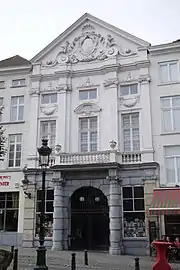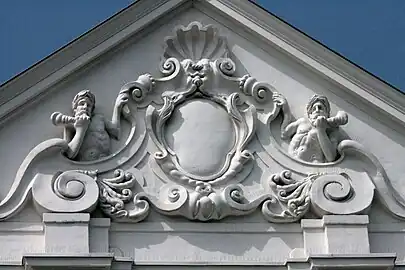Bortier Gallery
The Bortier Gallery (French: Galerie Bortier, Dutch: Bortiergalerij) is a glazed shopping arcade in Brussels, Belgium. It was designed by Jean-Pierre Cluysenaer in 1847, in a neo-Renaissance style, and opened in the following year. As well as being one of the first European shopping arcades, it is a fine example of the joint use of cast iron and glass.
| Galerie Bortier (French) Bortiergalerij (Dutch) | |
 | |
| Location | City of Brussels, Brussels-Capital Region, Belgium |
|---|---|
| Coordinates | 50°50′40″N 4°21′18″E |
| Address | Rue de la Madeleine / Magdalenastraat 55 |
| Opening date | 1848 |
| Developer | Pierre Bortier, City of Brussels |
| Owner | City of Brussels |
| Architect | Jean-Pierre Cluysenaer |
| Public transit access | Brussels-Central |
The gallery is situated in the centre of the City of Brussels, between the Mont des Arts/Kunstberg and the Grand-Place/Grote Markt (Brussels' main square), and not far from the more monumental Royal Saint-Hubert Galleries. It is owned by the City of Brussels and is managed by its Land Administration services. This site is served by Brussels Central Station on lines 1 and 5 of the Brussels Metro.
History
Early history
Originally, the gallery was a part of the Marché de la Madeleine/Magdalenamarkt complex, a covered market also designed by the architect Jean-Pierre Cluysenaer. The facade on the Rue de la Madeleine/Magdalenastraat, in a Flemish Baroque style, antedates the construction of the gallery behind it. This front dates from 1763 and was recovered from the Hôtel des Grandes Messageries, a town house situated on that site.
The gallery owes its name to an investor named Pierre Bortier, who had acquired land between the Rue Duquesnoy/Duquesnoystraat and the Rue Saint-Jean/Sint-Jansstraat, made available by the demolition of the former Hôpital Saint-Jean/Sint-Janshospitaal. He proposed to the Brussels' authorities to build the Marché de la Madeleine/Magdalenamarkt. This covered market had its main entrance on the Rue Duquesnoy. Starting from the Hôtel des Grandes Messageries, located on the Rue de la Madeleine, the gallery passed along the rounded southern end of the market hall on the level of its first floor, and ended on the Rue Saint-Jean.
20th and 21st centuries
The Madeleine market was demolished in 1957 and replaced by a modern event hall, leaving only the original facade in place. The Bortier Gallery was thus detached from the market building. Very degraded, it was renovated in 1974 and again around 2010.
The place is now well known to lovers of literature and old books, being almost entirely occupied, with the exception of an art gallery, with stalls and second-hand booksellers. Jean-Baptiste Moens, known as the father of philately, ran a shop in the Bortier Gallery from 1853 onwards.
Gallery
 Facade on the Rue de la Madeleine/Magdalenastraat
Facade on the Rue de la Madeleine/Magdalenastraat Detail of the facade
Detail of the facade Interior
Interior Bookshop
Bookshop
References
Bibliography
- Willaumez, Marie-France (1983). Les passages-galeries du XIXe siècle à Bruxelles (in French). Brussels: Ministère de la Communauté française. pp. 49–56.
- Willaumez, Marie-France (1994). Trois visages de passages au XIXe siècle. Bruxelles, ville d'Art et d'Histoire (in French). Vol. 7. Brussels: Éditions de la Région de Bruxelles-Capitale.
External links
- Bortier Gallery on www.ebru.be
- Bortier Gallery in www.eurobru.be Archived 3 July 2009 at the Wayback Machine